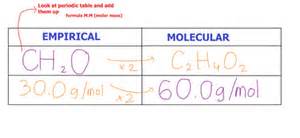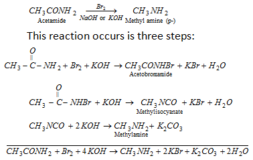Molecular Formula

source : quantum mechanics.mc multimedia .com
Q 1– % of C=40%, % of H=6.9% . At 2000C & 76 cm. Pressure 64.7 ml vapours are obtained by heating 0.10 gm. org. compd. calculate mol. formula of compound.
Ans. % of O = 100–(40+6.9) =53.1 %
| Element | % | Atomic weight | Relative no. of atoms | Simplest Ratio |
| C | 40 | 12 | 40/12=3.33 | 3.33/3.33=1 |
| H | 6.9 | 1 | 6.9/1=6.9 | 6.9/3.33=2 |
| O | 53.1 | 16 | 53.1/16=3.33 | 3.33/3.33=1 |
C:H:O=1:2:1
Empirical formula = CH2O
Empirical formula weight = 12+2+16 =30
Molecular formula =(CH2O)n
Calculation of Molecular weight by victor mayer’s method-
P1 V1/T1 =P2 V2/T2
T1= 200 +273 =473 K; V1 =64.7 ml. ; P1 = 76 cm. =760 mm.
At N.T.P,
P2 =760 mm. ;V2 = ? ml. ; T2= 273 K
P1 V1/T1 =P2 V2/T2
760 x 64.7 /473 =760 x V2 /273
V2 =37.34 ml.
vol. of vapours at N.T.P =37.34 ml.
mol. wt. =wt. of substance x 22400/ vol. of vapours at N.T.P
=0.10 x 22400 /37.34
mol.wt. =60.0
n = mol.wt. / Empirical formula weight
n =60/30 =2
Molecular formula =(CH2O)n
=(CH2O)2
Molecular formula = C2H4O2 Ans.
Q 2— A compound of C, H & N contain the elements in the ratio of 18:2:7 Calculate its empirical formula. If mol. wt. is 108. What is its mol. formula
Ans. C: H: N= 18:2:7
sum of ratio= 18+2+7
= 27
% of C= 18 x 100/27 =66.67 %
% of H=2 x 100 /27 =7.4 %
% of N = 7 x 100 /27 =25.93 %
| Element | % | Atomic weight | Relative no. of atoms | Simplest Ratio |
| C | 66.67 | 12 | 66.67/12=5.55 | 5.55/1.85=3 |
| H | 7.4 | 1 | 7.4/1=7.4 | 7.4/1.85=4 |
| N | 25.93 | 14 | 25.93/14=1.85 | 1.85/1.85 =1 |
C:H:N:O=4:8:2:1
Empirical Formula = C3H4N
Empirical Formula weight = 12 x 3 +1 x 4 +14 x 1= 54
Mol. formula = (C3H4N )n
mol.wt. = 108
n =mol. wt. / Empirical Formula weight
n = 108 / 54=2
Mol. formula = (C3H4N )n
= (C3H4N )2
Mol. formula = C6H8N2 Ans.
Q 3–The analysis of an organic compound gave the following data ;
(a)- 0.4020 gm. gave 0.6098 gm.& 0.2080 gm. of CO2 &H2O respectively.
(b)-1.01 gm. by kjeldahl’s method produced NH3 which was neutralised by 23.2 ml.N/2 acid.
(c)-0.1033 gm. of organic compound gave 0.2772 gm.BaSO4.
(d)-0.1015 gm.when vapourised by victor meyer’s method 27.96 ml.of air at 150C &766 mm. pressure.Calculate molecular formula.( P’ H2O at 150C =16 mm.)
Ans.
(a) wt.of org. compd =0.4020 gm. ; wt. of CO2=0.6098 gm. ; wt. of H2O =0.2080 gm.
% of C =12 x wt. of CO2 x 100 /44 x wt.of org. compd
=12 x 0.6098 x 100 /44 x 0.4020
% of C =41.37 %
% of H =2 x wt. of H2O x 100 /18 x wt.of org. compd
=2 x 0.2080 x 100/18 x 0.4020
% of H =5.75 %
(b) w =1.01 gm. ;N =1/2 ;V = 23.2 ml.
% of Nitrogen = 1.4 NV/w
=1.4 x 0.5 x 23.2/1.01
% of Nitrogen =16.08 %
(c) wt.of org. compd =0.1033 gm. ; wt. of BaSO4 = 0.2772 gm.
% of S =32 x wt. of BaSO4 x 100 /233 x wt.of org. compd
=32 x 0.2772 x 100 /233 x 0.1033
% of S =36.85 %
| Element | % | Atomic weight | Relative no. of atoms | Simplest Ratio |
| C | 41.37 | 12 | 41.37/12=3.45 | 3.45 /1.15 =3 |
| H | 5.75 | 1 | 5.75/1= 5.75 | 5.75/1.15=5 |
| N | 16.08 | 14 | 16.08/14=1.15 | 1.15/1.15 =1 |
| S | 36.85 | 32 | 36.85/32 =1.15 | 1.15 /1.15=1 |
C:H:N:S=3:5:1:1
Empirical Formula = C3H5N S
Empirical Formula weight = 12 x 3 +1 x 5 +14 x 1 +1 x 32= 87
Mol. formula = (C3H5N S )n
(d) Calculation of Molecular weight by victor mayer’s method-
P1 V1/T1 =P2 V2/T2
T1= 15 +273 =288 K; V1 =27.96 ml. ; P1 =766 – 16 = 750 mm.
At N.T.P,
P2 =760 mm. ;V2 = ? ml. ; T2= 273 K
P1 V1/T1 =P2 V2/T2
750 x 27.96 /288 =760 x V2 /273
V2 = 26.16 ml.
vol. of vapours at N.T.P = 26.16 ml.
mol. wt. =wt. of substance x 22400/ vol. of vapours at N.T.P
=0.1015 x 22400 /26.16
mol.wt. =86.9 =87
n = mol.wt. / Empirical formula weight
n =87/87 =1
Molecular formula =(C3H5NS)n
= (C3H5NS)1
Molecular formula = C3H5NS Ans.







